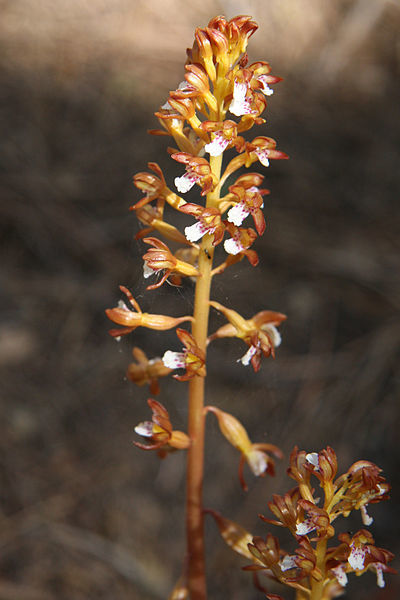Based on the mode of nutrition, orchids are categorized into: epiphytes, terrestrials and saprophytes. Epiphytic orchids as well as terrestrial orchids are preferred by the growers, but saprophytic orchids are least preferred. These orchids are mostly seen growing in research facilities and not in nurseries, because researcher mainly focus on their conservation and to use them as research material, while nurseries don't find them profitable enough. As most of the time saprophytic orchids survive by remaining hidden underground, in form of rhizomes or fleshy tubers, which serve as food reservoir as well as place from where the new growth arises; and the above ground parts grow out only at the time of flowering.
The saprophytic orchids grow in the soils which lack nitrogenous compounds, so to fulfil their nutrition requirement they have adapted to a different way of nutrition. This mode of nutrition has also made them to change their morphological structure; their leaves are reduced to mere scales. Saprophytes such as some of the Corallorhiza species lack chlorophyll and are mostly leafless. They get their nutrition with the help of mycorrhizal fungi; which is present in the soil and within the root cells. Saprophytic orchids do not possess true roots, instead have rhizomatous or fleshy fibrous roots.
When the time comes the resting underground parts sends out flowering shoots. Flowers of these orchids are no less than other orchids; and some just as beautiful. These are also known not to flower every year. One good thing about saprophytes is that they are not affected by pest and diseases that are common to other orchids. Existing most of the time underground, saprophytes escape many infections and pests which infect the above ground parts such as stem and leaves.
A lot of patience is required to grow saprophytes. Caring for saprophytes is also much easier as they do not require much attention. Apart from keeping an eye on rotting of the underground parts, watering is not required frequently. These mostly prefer to grow in leaf litter and depending upon the natural growth habit; they may or may not require sunlight.
 Spotted coralroot (Corallorhiza maculata) closeup, saprophytic orchid with small brownish flowers, pink-spotted white lip.
Photography credit: Jane Shelby Richardson
Spotted coralroot (Corallorhiza maculata) closeup, saprophytic orchid with small brownish flowers, pink-spotted white lip.
Photography credit: Jane Shelby Richardson
Saprophytic Orchids
Curiosityby Anu Dharmani
Originally published in BellaOnline
Posted by Sys Admin about 9 years ago.Article Blog Article Index
Share on Social Media:
New Topics
- David George asked question Odom's Fascination - an unusual orchid in category General Discussion
- Carol Holdren asked question Grow Tent in the Garage in category General Discussion
- David George asked question rlc Caotan Beauty found at Home Depot in category Cattleya Alliance
- Kristin Dorris asked question Odontocidium Orchid fungus? in category General Discussion
- Maria Fernandez asked question Wild. Lisa Devos in category Dendrobiums
New Comments
- Carol Holdren commented on topic "rlc Caotan Beauty found at Home Depot " by David George
- Carol Holdren commented on topic "Odom's Fascination - an unusual orchid" by David George
- Dr. Florian Wolf commented on topic "Wild. Lisa Devos" by Maria Fernandez
- Michael Valcarcel commented on member plant Rlc. Chief Takanaka by Walceli Muniz Valverde
- Michael Valcarcel commented on member plant Rlc. Montana Spirit by Michael Valcarcel
- Michael Valcarcel commented on member plant Ctt. Blazing Sun by Michael Valcarcel
- Michael Valcarcel commented on member plant Bc. Spotted Clown by Michael Valcarcel
- Maria Skrypnyk commented on member plant Yamadara Redland Sunset by Maria Skrypnyk
- André Pessina commented on topic "Odontocidium Orchid fungus?" by Kristin Dorris
- Linda Hartman commented on topic "Image of a plant please" by Leshya Perkins
- Paul Reavis commented on orchid Milt. Kismet
- Christiaan Viljoen commented on member plant Psh. fragrans by Christiaan Viljoen
- Christiaan Viljoen commented on member plant Z. maculatum by Christiaan Viljoen
- Christiaan Viljoen commented on member plant C. Gaskell-Pumila 'Azure Star' by Christiaan Viljoen
- Robert H. Findlay commented on member plant Rlc. Joy Sokabe var. Volcano Queen by Sally K
- James Lunsford commented on member plant Lc. Sagarik Wax 'African Beauty AMO/AOS x Blc. Cherry Suisse'Kauai' HCC/AOS var. Cattlyea 'Hybrid ' by James Lunsford
- John Varigos commented on orchid Bulb. schwarzii
- Linda Hartman commented on topic "Issue with Blc. Ben O'Neil "Jubilee" by Glenda Ratliff
- Henry Shaw commented on member plant Ons. Catatante 'Los Roble' by Henry Shaw
- Mary Lane commented on member plant Den. Tianmu Canary by Terre Moore